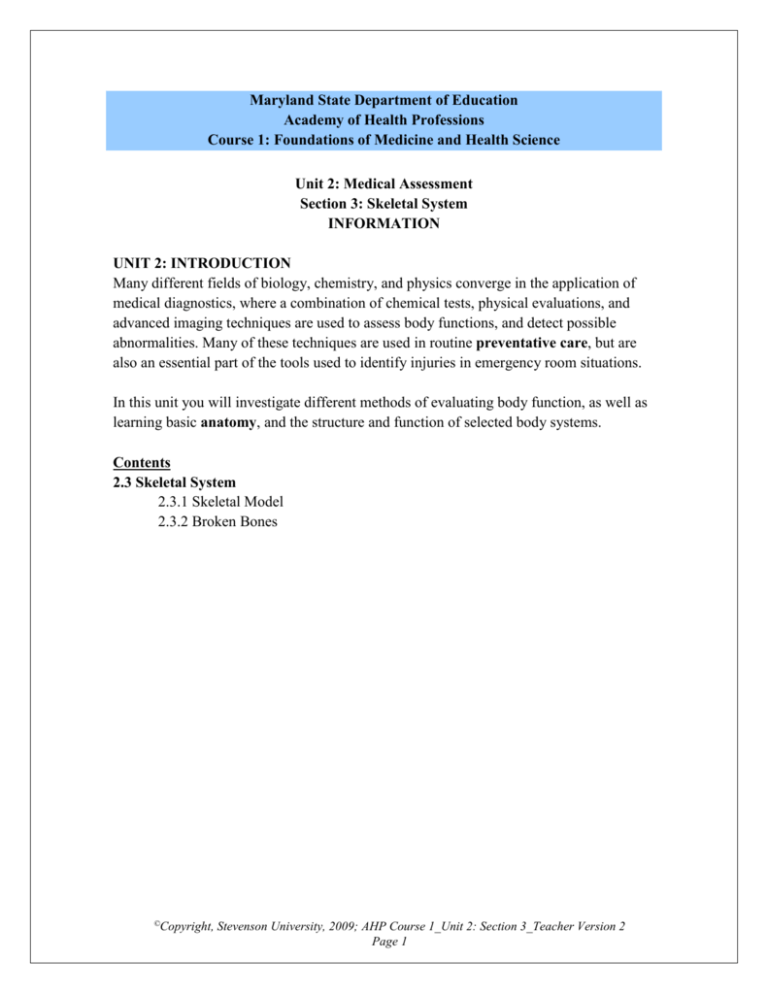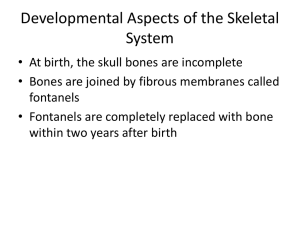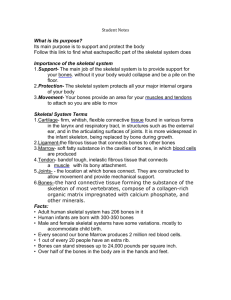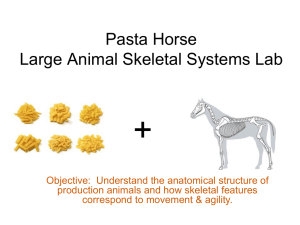Maryland State Department of Education Academy of Health
advertisement

Maryland State Department of Education Academy of Health Professions Course 1: Foundations of Medicine and Health Science Unit 2: Medical Assessment Section 3: Skeletal System INFORMATION UNIT 2: INTRODUCTION Many different fields of biology, chemistry, and physics converge in the application of medical diagnostics, where a combination of chemical tests, physical evaluations, and advanced imaging techniques are used to assess body functions, and detect possible abnormalities. Many of these techniques are used in routine preventative care, but are also an essential part of the tools used to identify injuries in emergency room situations. In this unit you will investigate different methods of evaluating body function, as well as learning basic anatomy, and the structure and function of selected body systems. Contents 2.3 Skeletal System 2.3.1 Skeletal Model 2.3.2 Broken Bones © Copyright, Stevenson University, 2009; AHP Course 1_Unit 2: Section 3_Teacher Version 2 Page 1 Academy of Health Professions Course 1: Foundations of Medicine and Health Science 2.3 SKELETAL SYSTEM The skeletal system is composed of 206 bones and serves many important functions. Its most important role is that of support, as it forms a skeletal frame that holds our bodies upright. In addition, it has a protective function by encasing vital organs such as the brain and lungs in bone to prevent damage to this delicate tissue. Although the skeletal system provides a rigid support system, it also allows for movement due to the presence of joints and interactions with muscles. In addition the bone marrow within bones is the production site of red blood cells, and bones also serve as storage areas for minerals such as phosphorus and calcium. 2.3. Prerequisite Skills and Knowledge Ability to use internet or other reference source. A basic understanding of the function of the skeletal system. 2.3 Activity Learning Objectives After completing this section students will be able to: Identify the major bones in the skeletal system. Name the major bones in the skeletal system. Describe the functions of components of the skeletal system. Relate the structure of bones to their function. Identify the major bones in the skeletal system from X-ray images. Describe and perform techniques for stabilizing fractures. 2.3 Activity Outcomes Relevant AHP Program Outcomes Explain the systems of the human body, their structure and function, and their interdependence on each other. Demonstrate effective communication skills through reading, writing, listening and speaking. Present information visually, verbally and in written form to peer and professional audiences utilizing a variety of methods. Describe the effect of external forces upon human body systems. Demonstrate the scientific process, health care related problem-solving skills and the application of health care technologies. Relevant Course Outcomes © Copyright, Stevenson University, 2009; AHP Course 1_Unit 2: Section 3_Teacher Version 2 Page 2 Explain the basic structure and functions of human body systems in health and illness. Perform technical procedures used in a variety of medical settings. Accurately use medical terminology Perform basic first aid skills and obtain first aid certification from the American Heart Association. Relevant National Healthcare Foundation Standards Standard 1: Academic Foundation: Healthcare professionals will know the academic subject matter required for proficiency within their area. They will use this knowledge as needed in their role. The following accountability criteria are considered essential for students in a health science program of study. o Accountability Criteria 1.11 – Classify basic functional and structural organization of the human body (chemical, cellular, tissue, organ, and system). o Accountability Criteria 1.12 – Recognize body planes, directional terms, quadrants, and cavities. o Accountability Criteria 1.13 – Analyze basic structure and function of the human body o Accountability Criteria 1.21 – Describe common diseases and disorders of each body system (prevention, pathology, diagnosis, and treatment). o Accountability Criteria 1.23 – Investigate biomedical therapies as they relate to prevention, pathology, and treatment of disease. Standard 4: Employability Skills – Healthcare professionals will understand how employability skills enhance their employment opportunities and job satisfaction. They will demonstrate key employability skills and will maintain and upgrade skills, as needed. o Accountability Criteria 4.32 – Recognize levels of education, credentialing requirements, employment opportunities, workplace environments, and career growth potential. o Accountability Criteria 4.41 – Develop components of a personal portfolio. Standard 10: Technical Skills – Healthcare professionals will apply technical skills required for all career specialties. They will demonstrate skills and knowledge as appropriate. o Accountability Criteria 10.11 – Apply procedures for measuring and recording vital signs. © Copyright, Stevenson University, 2009; AHP Course 1_Unit 2: Section 3_Teacher Version 2 Page 3 o Accountability Criteria 10.12 – Apply skills to obtain training or certification in cardiopulmonary resuscitation (CPR), automated external defibrillator (AED), foreign body airway obstruction (FBAO), and first aid. 2.3 Activity Deliverables Upon completion of this Section, each student will provide the following products to be included in a portfolio: 2.3.1 Skeletal System Model: o Worksheet 14: Bone Structure and Function o Skeletal System Exam Questions – the full test is to be inserted into the Course 1 Portfolio. 2.3.2 Broken Bones: o First aid Certification(if available) – a copy of the certificate is to be placed in the Course 1 Portfolio. © Copyright, Stevenson University, 2009; AHP Course 1_Unit 2: Section 3_Teacher Version 2 Page 4 Academy of Health Professions Course 1: Foundations of Medicine and Health Science 2.3.1 Skeletal Model 2.3.1 Lesson Summary Students will use a model skeleton to identify the components of the skeletal system and describe their function. They will then write exam questions on bone structure and function. 2.3.1 Activity Background The skeletal system is a complex structure made up of many different bones which function in different ways. Some bones structures are primarily involved in protection, while others play a pivotal role in movement. 2.3.1 Prerequisite Skills and Knowledge Ability to use internet or other reference source. A basic understanding of the function of the skeletal system. 2.3.1 Activity Learning Objectives After completing this activity students will be able to: Identify the major bones in the skeletal system. Name the major bones in the skeletal system. Describe the functions of components of the skeletal system. Relate the structure of bones to their function. 2.3.1 Activity Outcomes Relevant AHP Program Outcomes Explain the systems of the human body, their structure and function, and their interdependence on each other. Demonstrate effective communication skills through reading, writing, listening and speaking. Present information visually, verbally and in written form to peer and professional audiences utilizing a variety of methods. © Copyright, Stevenson University, 2009; AHP Course 1_Unit 2: Section 3_Teacher Version 2 Page 5 Relevant Course Outcomes Explain the basic structure and functions of human body systems in health and illness. Perform technical procedures used in a variety of medical settings. Accurately use medical terminology. Relevant National Healthcare Foundation Standards Standard 1: Academic Foundation: Healthcare professionals will know the academic subject matter required for proficiency within their area. They will use this knowledge as needed in their role. The following accountability criteria are considered essential for students in a health science program of study. o Accountability Criteria 1.11 – Classify basic functional and structural organization of the human body (chemical, cellular, tissue, organ, and system). o Accountability Criteria 1.12 – Recognize body planes, directional terms, quadrants, and cavities. o Accountability Criteria 1.13 – Analyze basic structure and function of the human body Standard 4: Employability Skills – Healthcare professionals will understand how employability skills enhance their employment opportunities and job satisfaction. They will demonstrate key employability skills and will maintain and upgrade skills, as needed. o Accountability Criteria 4.41 – Develop components of a personal portfolio. 2.3.1 Activity Description Students will be divided into groups of four, and each member of the group will be assigned one of four regions of the skeleton to research. Students will research the names, location, structure and function of all of the bones in their designated region. The teacher will test each group by asking them to identify bones on a skeletal model, and relate the bone’s structure to its function, with each individual group member responsible for their own designated region. The group will then prepare exam questions testing knowledge of the whole skeletal system, which will be used by the teacher prepare a class test. © Copyright, Stevenson University, 2009; AHP Course 1_Unit 2: Section 3_Teacher Version 2 Page 6 2.3.1 Activity Deliverable Worksheet 14: Bone Structure and Function Skeletal System Exam Questions – the full test is to be inserted into the Course 1 Portfolio. 2.3.1 Materials and Equipment A reference source such as textbook or access to the internet A full size model or poster of a human skeleton Worksheet 14: Bone Structure and Function 2.3.1 Teaching Notes Below is a list of the different regions of the skeletal system and the bones which are found in these regions. One member of each group will be responsible for researching an assigned region. Once research is complete, you will call up each group in turn and ask them to identify on a model skeleton or skeletal diagram in front of the class, one or more bones from each region selected from the list below, as well as answering questions on their structure and function. The students will not know in advance which bones they will be required to identify from their assigned regions. The group member responsible for each particular region will answer the relevant questions. Exam Questions: Following the question and answer sessions, each group will compose 10 questions which test knowledge of bones from each region of the skeletal system. Once you have received these questions, you will grade the quality and inventiveness of the questions using the rubric provided, and will then use the best questions to compose a class test on the skeletal system. Students will put a copy of the complete test in their Course 1 Portfolio. Students will probably need some guidance and practice at writing exam questions. These questions should test simple recall, as well as brief constructed responses. 2.3.1 Additional Activities Make your own skeleton: Students could make a model of their own skeleton using brads and cardboard. Working in pairs of the same sex, they would take approximate measurements of each bone and use these to make their own skeleton. Skeleton Assembly: Students could visit the website http://sv.berkeley.edu/showcase/pages/bones.html which features an interactive animation. Students reassemble a disarticulated skeleton, which waves to them when correct assembled. The name of each bone is revealed when clicked upon. © Copyright, Stevenson University, 2009; AHP Course 1_Unit 2: Section 3_Teacher Version 2 Page 7 2.3.1 Regions of the Skeletal System for Student Investigation: AXIAL SKELETON:SPINAL COLUMN AND THORAIC CAGE Thoracic cage: o Sternum o Ribs Spinal column vertebrae: o Cervical o Thoracic o Lumbar o Sacral o Coccygeal APPENDICULAR SKELETON: PECTORAL GIRDLE AND UPPER LIMBS Pectoral girdle: o Clavicle o Scapula Humerus Ulna Radius Carpus Metacarpal bones Phalanges AXIAL SKELETON: THE SKULL Frontal bone Parietal bone Temporal bone Occipital bone Zygomatic bone Maxilla Mandible APPENDICULAR SKELETON: PELVIC GIRDLE AND LOWER LIMBS Pelvic Girdle Os coxae Femur Patella Tibia Fibula Tarsus Metatarsal bones Phalanges Calcaneus © Copyright, Stevenson University, 2009; AHP Course 1_Unit 2: Section 3_Teacher Version 2 Page 8 2.3.1 Skeletal System Model Human Skeleton http://en.wikipedia.org/wiki/Human_skeleton © Copyright, Stevenson University, 2009; AHP Course 1_Unit 2: Section 3_Teacher Version 2 Page 9 Academy of Health Professions Course 1: Foundations of Medicine and Health Science 2.3.2 Broken Bones 2.3.2 Lesson Summary Students will identify broken bones from X-ray images and will learn the techniques required to stabilize the fractures. 2.3.2 Activity Background The human skeletal system is designed to support the human body, offer it protection, and provide a means of locomotion. Bone is the essential framework to which muscles are attached. When a bone breaks, it is called a fracture. There's more than one way to break or fracture a bone. A break can be anything from a hairline fracture (a thin break in the bone) to the bone that's snapped in two pieces like a broken tree branch. Fractures can be described in the following ways: • Simple—the bone is broken in one place. • Comminuted—the bone is broken in several places with at least 3 bone fragments. • Open—the skin is injured exposing the broken bone (also called “compound”). • Closed—the skin is intact over the broken bone. • Undisplaced—the broken bone pieces are aligned. • Displaced—the broken bone pieces are not aligned. Keeping the broken body part stationary -- immobilizing it -- will stabilize the injured area and prevent the bones from shifting until further treatment is available. Splints are used to immobilize an area. They can be made from cardboard, newspapers, sticks, or any other rigid material. When Paramedics treat patients at the scene of accidents, they frequently carry out procedures to stabilize fractures before they transport the patient to hospital. Once fractures have been identified by using X-ray imaging, a cast is usually applied to the damaged bone to immobilize it. Before applying a cast, an emergency room doctor will first check to make sure that the bones are in correct alignment to promote proper healing. A cast which is usually made from plaster holds the bones in place to allow them to grow back and heal in the desired configuration. 2.3.2 Prerequisite Skills and Knowledge Ability to use internet or other reference source. © Copyright, Stevenson University, 2009; AHP Course 1_Unit 2: Section 3_Teacher Version 2 Page 10 A basic understanding of the structure and function of the skeletal system. 2.3.2 Activity Learning Objectives After completing this activity students will be able to: Identify the major bones in the skeletal system from X-ray images. Name the major bones in the skeletal system. Describe and perform techniques for stabilizing fractures. 2.3.2 Activity Outcomes Relevant AHP Program Outcomes Explain the systems of the human body, their structure and function, and their interdependence on each other. Describe the effect of external forces upon human body systems. Demonstrate the scientific process, health care related problem-solving skills and the application of health care technologies. Relevant Course Outcomes Explain the basic structure and functions of human body systems in health and illness. Perform technical procedures used in a variety of medical settings. Accurately use medical terminology Perform basic first aid skills and obtain first aid certification from the American Heart Association. Relevant National Healthcare Foundation Standards Standard 1: Academic Foundation: Healthcare professionals will know the academic subject matter required for proficiency within their area. They will use this knowledge as needed in their role. The following accountability criteria are considered essential for students in a health science program of study. o Accountability Criteria 1.11 – Classify basic functional and structural organization of the human body (chemical, cellular, tissue, organ, and system). o Accountability Criteria 1.12 – Recognize body planes, directional terms, quadrants, and cavities. o Accountability Criteria 1.13 – Analyze basic structure and function of the human body o Accountability Criteria 1.21 – Describe common diseases and disorders of each body system (prevention, pathology, diagnosis, and treatment). o Accountablility Criteria 1.23 – Investigate biomedical therapies as they relate to prevention, pathology, and treatment of disease. © Copyright, Stevenson University, 2009; AHP Course 1_Unit 2: Section 3_Teacher Version 2 Page 11 Standard 4: Employability Skills – Healthcare professionals will understand how employability skills enhance their employment opportunities and job satisfaction. They will demonstrate key employability skills and will maintain and upgrade skills, as needed. o Accountability Criteria 4.32 – Recognize levels of education, credentialing requirements, employment opportunities, workplace environments, and career growth potential. o Accountability Criteria 4.41 – Develop components of a personal portfolio. Standard 10: Technical Skills – Healthcare professionals will apply technical skills required for all career specialties. They will demonstrate skills and knowledge as appropriate. o Accountability Criteria 10.11 – Apply procedures for measuring and recording vital signs. o Accountability Criteria 10.12 – Apply skills to obtain training or certification in cardiopulmonary resuscitation (CPR), automated external defibrillator (AED), foreign body airway obstruction (FBAO), and first aid. 2.3.2 Activity Description In this activity, you will learn the basic first-aid principles of stabilizing a broken or fractured bone. This assignment will help you to understand why a break should be immobilized and the proper procedures of how this is to be done. You will also learn what materials work best to stabilize the bones. You will observe how to splint a fractured limb, and learn the importance of immobilization in the treatment of broken bones. You will also experience the sensation of limited movement created by a splint or a cast. While working on this activity you will be examining x-rays provided by your teacher or bone images in your workbook/guide, to understand what a break looks like. When examining the x-ray images, you must be able to determine what part of the body the break or fracture is located in and how you would best stabilize this type of injury. 2.3.2 Activity Deliverables First aid certification (if available) – a copy of the certificate is to be placed in the Course 1 Portfolio. © Copyright, Stevenson University, 2009; AHP Course 1_Unit 2: Section 3_Teacher Version 2 Page 12 2.3.2 Materials and Equipment First Aid Workbook OR another guide on splinting broken bones X-ray images or x-ray printouts from internet resources Medical supplies used for splinting, or the following substitutes: o Cardboard scraps for splints (use old cardboard boxes and cut strips to fit the corresponding bones you are working on) o Wood scraps or sticks for splints o Scissors o Triangular bandages made from torn sheets or fabric scraps o Newspapers o Padding for splinting (foam or thicker fabric) 2.3.2 Additional Resources Websites with online x-ray or broken bone images: http://www.accessexcellence.org/RC/VL/xrays/ http://www.colorado.edu/physics/2000/xray/index.html http://www.innerbody.com/image/skel06.html Websites for purchasing broken bone x-rays: http://www.enasco.com/product/SB43367M http://www.deltaeducation.com/productdetail.aspx?Collection=N&prodID=6651&menuID http://www.k5kaplan.com/store/trans/productDetailForm.asp?CatID=48%7C8 %7C0&CollID=33217 http://www.bookofjoe.com/2007/09/broken-bones-x-.html 2.3.2 Resources American Red Cross standard first aid workbook. (1988) Washington, DC: American Red Cross. Gray, H. (1901, 1977) Gray's anatomy. New York: Bounty Books. Kapit, W., and L. Elson. (1977) The anatomy coloring book. New York: Harper Collins. Community resources o American Red Cross chapter o American Heart Association o School nurse o Emergency-response units o Hospitals or emergency-treatment centers © Copyright, Stevenson University, 2009; AHP Course 1_Unit 2: Section 3_Teacher Version 2 Page 13 2.3.2 Teaching Notes There is no assessment of the activity described above. Instead, the deliverable for this activity is for students to obtain basic First Aid certification from the American Heart Association, American Red Cross, or another such agency. A copy of certificates should be inserted into the Course 1 Portfolio. If this certification is not possible, teachers should arrange for a healthcare professional such as an EMT or the school nurse to come in and demonstrate basic first aid techniques to the class. © Copyright, Stevenson University, 2009; AHP Course 1_Unit 2: Section 3_Teacher Version 2 Page 14








